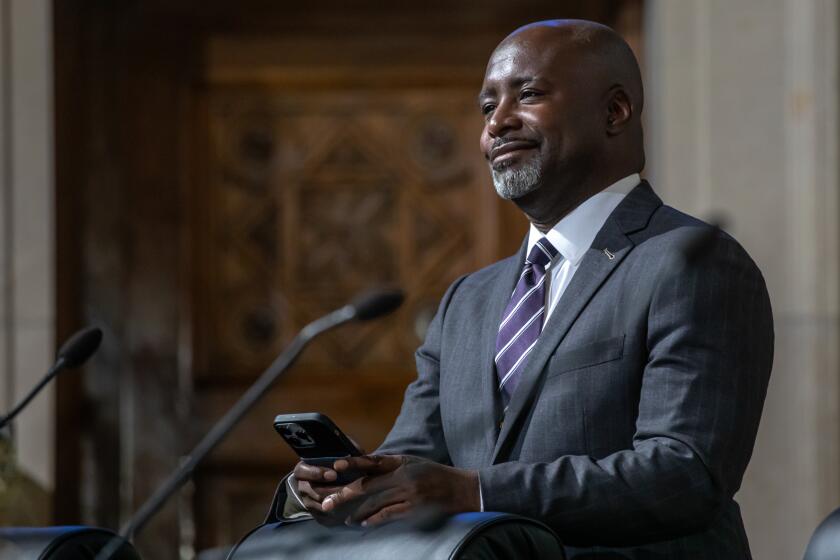Mobilization for King Verdict Costly but Had Payoffs
- Share via
SAN GABRIEL VALLEY — San Gabriel Valley police and sheriff’s deputies, still adding up costs from last weekend’s beefed-up enforcement in preparation for the verdicts in the Rodney G. King civil rights trial, are also crediting their accounts with increased goodwill and a lower-than-usual weekly crime rate.
“I think there are two things we gained,” El Monte Assistant Police Chief Pete Mireles said. “We saw a big decline in our serious crimes of about 50%, and the comments from our residents and business sector were that it was comforting to see us out there in force.”
Law enforcement officials also said the extra deployment enabled them to experience an actual run-through of their tactical plans. Such plans can be used in any disaster, emergency or special event, officials said, including the July trial of three African-American men accused of beating truck driver Reginald Denny during last year’s riots that followed the not guilty verdicts in the state trial of four Los Angeles officers accused of beating the Altadena motorist.
Countywide, police and deputies with riot helmets and tear gas were in place on the streets at 6 a.m. Saturday. They awaited verdicts, announced an hour later, in Los Angeles Federal Court. Two officers were convicted and two were acquitted.
The five days of widespread violent, urban unrest last year resulted in 52 deaths, more than 10,000 businesses destroyed and $1 billion worth of damage in arson and looting. Police were caught off guard and outnumbered.
This time, police were ready. But trouble never materialized.
Still, many San Gabriel Valley police departments kept extra officers in place through the weekend working 12-hour shifts. Command posts were opened in some cities, special booking procedures used in others and officers kept on standby until Sunday evening.
Some cities, such as Sierra Madre and Pomona, did not go to full alert but increased the number of cars on patrol and kept officers on standby.
Costs varied for each city, with estimates ranging from about $50,000 in Pasadena and $30,000 in El Monte to $2,500 in tiny Sierra Madre with its 15-officer police force.
Costs for the Sheriff’s Department totaled $1 million countywide for each day of full mobilization. No breakdown of costs was given for the four sheriff’s stations operating in the San Gabriel Valley.
“Cost was not even a consideration for this,” said Alhambra Police Capt. Al Solomon, who added that his department is still tallying overtime expenses.
“I think there’s a payoff down the line,” El Monte’s Miller said of the costs, “because we’re going to be a little bit more prepared. Right now, we’re at a high state of readiness and training for anything that comes along.”
With the skills acquired in preparation and during the weekend mobilization, police and deputies are equipped to handle anything from a plane crash to a large rock concert at Legg Lake, the the assistant police chief said.
“You’ve got to experience the actual staffing and mobilization, which you can’t normally do because it costs so much,” added Lt. Jack Miller of the Temple sheriff’s station. “You can do it (mobilization) on paper, but it doesn’t really work.”
The weekend mobilization enabled Pasadena to test its quick-booking procedure, normally used only on New Year’s Eve, Police Lt. Robert Huff said. Under the system, officers are kept in the field where they are needed instead of driving prisoners to jail. Other officers in jail vans make rounds, pick up the prisoners and book them in groups of five and six at police headquarters, Huff said.
Pomona staffed a command post on the east side of town with a trailer equipped with computers and radios and a parking lot big enough to accommodate large groups of officers and cars for staging, Police Lt. Leon Sakamoto said.
Police departments in smaller cities upgraded their equipment, such as gas masks and tear gas, in preparation for the mobilization. These departments were also able to receive riot training in the weeks before deployment from the Sheriff’s Department. Such training, abandoned since civil unrest in the 1960s and 1970s, was resurrected and updated two years ago by the department, Miller, the Temple City station lieutenant, said.
With the streets filled with trained and riot-equipped officers, crime was significantly down in the San Gabriel Valley, officials said. Although reports of domestic violence, drunk driving and drunkenness remained at about normal levels, robbery and burglary calls were down, most said.
“It seemed like everything was totally dead,” Huff said of the Pasadena area.
“People were unwilling to risk committing a crime and going to jail when they knew a bunch of us were around,” added Lt. Dennis Curran of the Walnut sheriff’s station.
More to Read
Sign up for Essential California
The most important California stories and recommendations in your inbox every morning.
You may occasionally receive promotional content from the Los Angeles Times.










